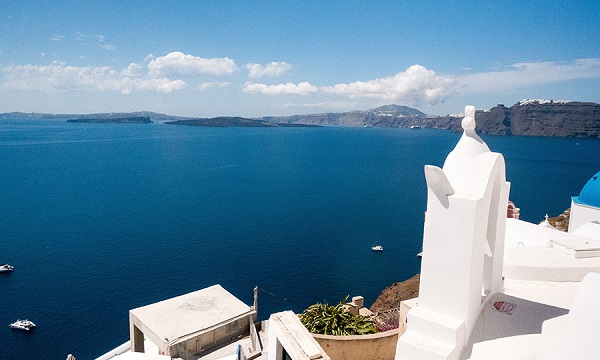Assyrtiko (Greece)
Assyrtiko is a white grape from the Greek island of Santorini.
Assyrtiko Flavors
Assyrtiko is fresh as a Lemonade, with flavors of Citrus and Stone Fruits. Floral notes and Volcanic Minerals.
Lemon |
Grapefruit |
Peach |
Passion |
Beeswax |
Flowers |
Volcanic |
Saline |
Assyrtiko Profile
Assyrtiko is light and dry with a mineral and crispy acidity:
| SUGAR: | Dry (3 g/l) |
| BODY: | Light |
| FRUIT: | Low |
| ACIDITY: | High |
| ALCOHOL: | 13-15% ABV |
| Serving temperature: 6-9°C (43-46°F) | |
Assyrtiko Food Pairing
Assyrtico is very food friendly, especially with grilled fish and seafood.
Aperitif |
Salads |
Olive Oil |
Seafood |
Oysters |
Shrimps |
Sardines |
Octopus |
Fish |
Chicken |
Chips |
Soft Cheese |
Excellent Pairings
Green Salads with Lemon Acid Vinaigrettes.
Light Seafood Salads with Crab, Shrimps, or Prawns.
Mussels. Garlic Prawns. Seafood Antipasti.
Grilled Octopus. Fried Calamari.
Grilled Sardines. Olive Oil Sardines.
Fried White Fish. Sea Bass. Mackerel.
Greek Specialities
Greek Salad.
Tomato Feta Salad.
Greek Scrambled Eggs.
Kakavia (Greek Fish Soup).
The Ideal Glass for Assyrtiko
A Tulip Shaped Glass with a slightly smaller bowl can be suitable for various dry white wines.

|
The glass guides the wine to the center of your mouth, avoiding the sides where acidity is less pleasant.
A smaller bowl also helps to serve smaller quantities, and keep the wine cold. It also helps if you hold the glass by the stem! |
Assyrtiko Cheese Pairing
Pairing Tips
Opt for cheeses with moderate saltiness and creaminess to balance the c's acidity.
Also try to add fresh fruits (grapes, apples, pears), nuts (almonds, walnuts), and a light drizzle of honey to enhance the pairing experiment.
Fresh and Mild Cheeses
Ricotta: Especially good if served with a drizzle of honey or fresh fruits.
Goat Cheese (Chèvre): The tanginess complements the subtle fruit notes found in Assyrtiko.
Soft Cheeses
Brie: The creamy texture and mild flavor work beautifully with c.
Camembert: Similar to Brie but with slightly more earthy.
Fontina: Its nutty, buttery qualities make a good match.
Semi-Soft Cheeses
Gruyère: Mildly nutty and sweet, enhancing the a subtile Assyrtiko.
Swiss Cheese: Assyrtiko has a refreshing acidity and floral aromas, which complement the nutty and slightly sweet flavors of a Swiss Chese.
Asiago: Lightly aged Asiago adds a complementary tang.
If You Like Assyrtiko
You May Also Like:
About Assyrtiko
Assyrtiko is a local grape from the Greece island of Santorini. It is known as the finest white wine in Greece and has a growing high quality reputation.
The terroir in Santorini is volcanic and it reflects on the minerality. Rainfall is scarce and it can be windy and sunny. The lack of clay and potassium in the soil gives the vines a natural immunity against diseases such Phylloxera.
The mineral profile of Assyrtiko blends well with other grapes like Sauvignon Blanc and Sémillon.
To protect the grapes, the Santorinians, had the brilliant idea to create spiral bush vines which grow low, close to the ground, and look like a basket. This method is called koulara and when the "basket" reaches 75 years of age it is cut and a new plant sprouts naturally, producing a harvest within 2-3 years.
Assyrtico is also used to make Vinsanto-like sweet dessert wines.
Aegean Islands


Black Grapes |
White Grapes |

|

|
Soil |
Climate |

Schist. |

Mediterranean. |

Santorini vines trained to the ground in a basket shape, to protect the grapes from heat and wind.
Aegean PDO Regions
Aegean Islands (East Mediterranean) has 5 PDO regions:
PDO Santorini (1971)
PDO Rhodos (1971)
PDO Lemnos (1982)
PDO Paros (1981)
PDO Samos (1970)
PDO Santorini (ΠΟΠ Σαντορίνη)
This picturesque island is one of Greece's most unique wine regions. Volcanic soil and strong winds contribute to the cultivation of grapes like Assyrtiko, which produces crisp, mineral-driven white wines with citrus and floral notes.
PDO Santorini allows for 85% Assyrtiko and 15% of Athiri and Aidani. However, most PDO Santorini is made from 100% Assyrtiko.
PDO Santorini has a unique profile, clearly showing the terroir. The wines are powerful and intense, bursting with sea-salt minerality. Not aromatic but steely with a depth of citrus fruit, and a high level of acidity and alcohol
PDO requirements:
Dry White from min 85% Assyrtiko + Athiri / Aidani.
Sweet White from min 51% Assyrtiko + Athiri / Aidani.
PDO Rhodes (ΠΟΠ Ρόδος)
Phylloxera existed on Rhodes, but had difficulties to spread in the a terrain. As a result, on the altitudes of Mount Attavyros there are numerous self-rooted Phylloxera immune vines of advanced age.
Rhodes is the leader and main source of Greek bottled-fermented sparkling wines. CAIR Brut is a famous sparkling wine produced by the local grape Athiri, using the French traditional method.
PDO requirements:
Red from min 70% Amorgiano + Mavrothiriko.
Rosé from min 70% Amorgiano + Mavrothiriko.
White from min 70% Athiri + Assyrtiko and Malagousia.
Amorgiano is the local name for the Mandilaria grape.
PDO Samos (ΠΟΠ Σάμος)
The White Muscat wine from Samos is often referred to as Muscat Samos since the grape is associated with the island.
Muscat is also found in four other Greece PDO wines: PDO Muscat of Rhodes. PDO Muscat of Cephalonia. PDO Muscat of Patras. PDO Muscat of Rio Patras.
PDO requirements:
Sweet White from 100% Muscat (Sun-dried).
Sweet White Fortified from 100% Muscat.
PDO Lemnos (ΠΟΠ Λήμνος)
Lemnos (Limnos) in the northern Aegean Sea is where the white grape Muscat of Alexandria is widely cultivated.
PDO requirements:
Dry White from 100% Muscat of Alexandria.
Medium-Dry White from 100% Muscat of Alexandria.
Medium-Sweet White from 100% Muscat of Alexandria.
Dry Red from 100% Limnio.
Sweet Red from 90% Limnio (sun-dried) and 10% Muscat.
Sweet Fortified Red from 90% Limnio and 10% Muscat.
Alcohol can be addictive. Always drink in moderation.
© Copyright 2015-2025 W3 Wine School. All Rights Reserved.






